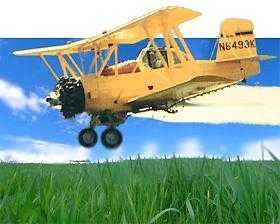Sun, Apr 28, 2024
NAAA Reminds Drone Operators to Yield to Agplanes
As the U.S. agricultural season kicks into high gear, the National Agricultural Aviation Association (NAAA) is calling on both professional and hobbyist drone operators to exercise heightened awareness and caution during their flights.

This appeal aims to mitigate the risks of aerial collisions as low-flying manned agricultural aircraft commence their crucial work over the nation's croplands.
Agricultural aviators are responsible for treating an impressive 127 million acres of U.S. cropland annually. These operations often occur at altitudes as low as 10 feet, at speeds up to 140 mph, making it extremely challenging for pilots to detect and avoid drones, which are typically mandated to fly below 400 feet without specific waivers from the FAA.

Andrew Moore, CEO of NAAA, emphasizes the critical nature of this issue: "It is extremely difficult, if not impossible, for manned aircraft to see a drone while conducting crop-enhancing and other aerial applications at low altitudes and high speeds. We urge drone operators to equip their UAS with detect and avoid technology and to always yield the right of way to manned aircraft to ensure a safe growing season."
The NAAA highlights several guidelines for drone operators to follow:
- Always give right of way to manned aircraft, as required by law.
- Equip drones with visible strobe lights, distinctive markings, and tracking technologies like ADS-B In systems.
- Obtain proper certification and training for safe and effective drone operation.
- Consult local agricultural operations before flight by using resources like the Find An Aerial Applicator database available at AgAviation.org.
- Land drones immediately if a low-flying manned aircraft is spotted nearby.
- Maintain adequate unmanned aircraft liability insurance.
These precautions come in response to an NAAA survey where 11% of agricultural pilots reported encountering a drone during flight operations last year, underscoring the growing concern over safe airspace cohabitation.
The FAA also supports these safety measures and will highlight them during their annual Drone Safety Day, reflecting the ongoing commitment to integrating drones safely into national airspace. As drone registrations and the number of certified remote pilots continue to rise sharply, the importance of conscientious drone operation cannot be overstated.
More News
Circle To Runway (Runway Number) Used by ATC to inform the pilot that he/she must circle to land because the runway in use is other than the runway aligned with the instrument appr>[...]
Aero Linx: National Aviation Safety Foundation (NASF) The National Aviation Safety Foundation is a support group whose objective is to enhance aviation safety through educational p>[...]
At Altitude Of About 250-300 Ft Agl, The Airplane Experienced A Total Loss Of Engine Power On November 6, 2024, at 1600 central standard time, a De Havilland DHC-1, N420TD, was inv>[...]
From 2009 (YouTube Edition): Three Hour Flight Was 'Flawless' -- At Least, Until Mother Nature Intervened For anyone who loves the aviation business, this was a VERY good day. Afte>[...]
Also: AMA Names Tyler Dobbs, More Falcon 9 Ops, Firefly Launch Unsuccessful, Autonomous F-16s The Air Force has begun ground testing a future uncrewed jet design in a milestone tow>[...]
 ANN's Daily Aero-Term (05.05.25): Circle To Runway (Runway Number)
ANN's Daily Aero-Term (05.05.25): Circle To Runway (Runway Number) ANN's Daily Aero-Linx (05.05.25)
ANN's Daily Aero-Linx (05.05.25) NTSB Prelim: De Havilland DHC-1
NTSB Prelim: De Havilland DHC-1 Classic Aero-TV: The Boeing Dreamliner -- Historic First Flight Coverage
Classic Aero-TV: The Boeing Dreamliner -- Historic First Flight Coverage Airborne-NextGen 05.06.25: AF Uncrewed Fighters, Drones v Planes, Joby Crew Test
Airborne-NextGen 05.06.25: AF Uncrewed Fighters, Drones v Planes, Joby Crew Test




